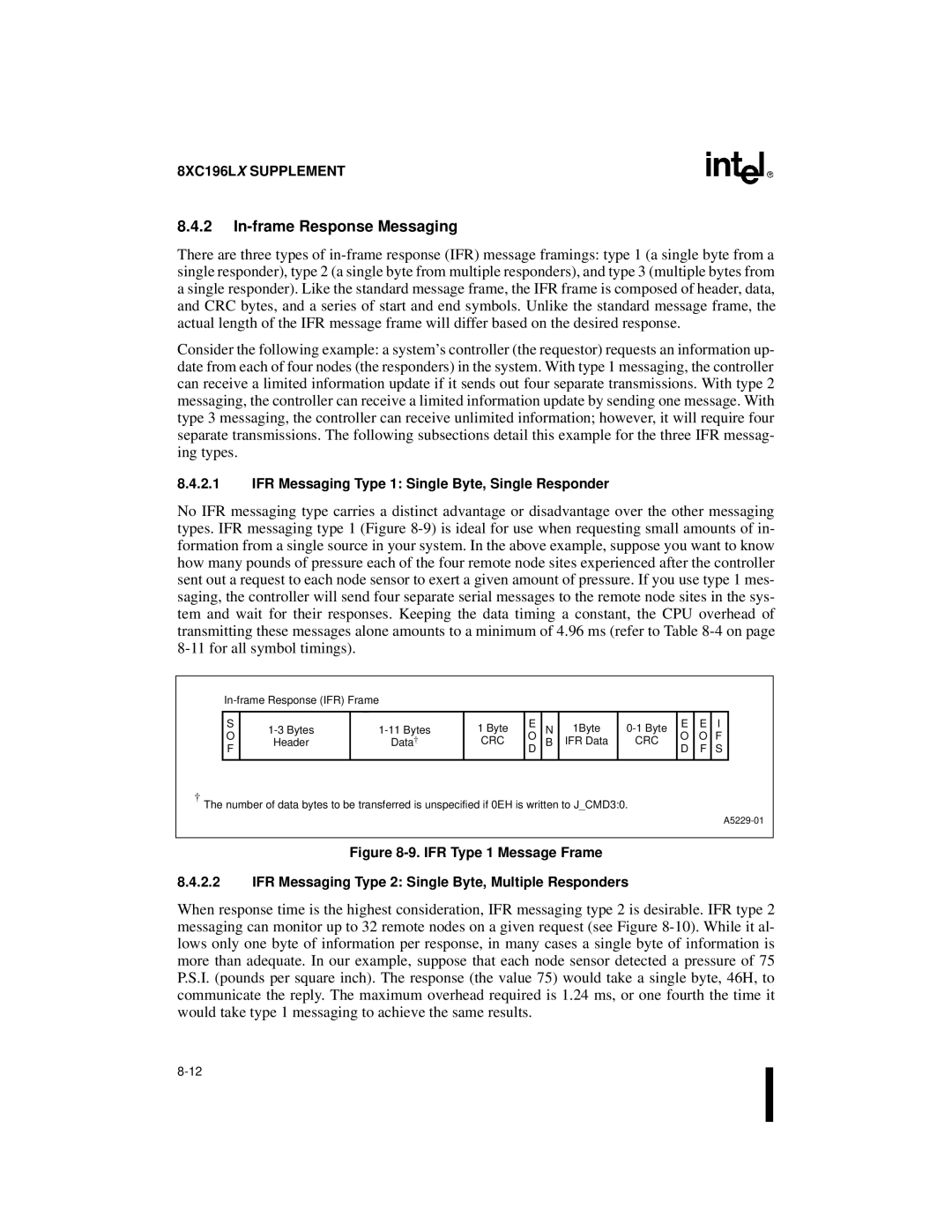8XC196LX SUPPLEMENT
8.4.2In-frame Response Messaging
There are three types of in-frame response (IFR) message framings: type 1 (a single byte from a single responder), type 2 (a single byte from multiple responders), and type 3 (multiple bytes from a single responder). Like the standard message frame, the IFR frame is composed of header, data, and CRC bytes, and a series of start and end symbols. Unlike the standard message frame, the actual length of the IFR message frame will differ based on the desired response.
Consider the following example: a system’s controller (the requestor) requests an information up- date from each of four nodes (the responders) in the system. With type 1 messaging, the controller can receive a limited information update if it sends out four separate transmissions. With type 2 messaging, the controller can receive a limited information update by sending one message. With type 3 messaging, the controller can receive unlimited information; however, it will require four separate transmissions. The following subsections detail this example for the three IFR messag- ing types.
8.4.2.1IFR Messaging Type 1: Single Byte, Single Responder
No IFR messaging type carries a distinct advantage or disadvantage over the other messaging types. IFR messaging type 1 (Figure 8-9) is ideal for use when requesting small amounts of in- formation from a single source in your system. In the above example, suppose you want to know how many pounds of pressure each of the four remote node sites experienced after the controller sent out a request to each node sensor to exert a given amount of pressure. If you use type 1 mes- saging, the controller will send four separate serial messages to the remote node sites in the sys- tem and wait for their responses. Keeping the data timing a constant, the CPU overhead of transmitting these messages alone amounts to a minimum of 4.96 ms (refer to Table 8-4 on page 8-11 for all symbol timings).
In-frame Response (IFR) Frame | | | | | | | | | | | |
S | 1-3 Bytes | | 1-11 Bytes | 1 Byte | E | N | 1Byte | 0-1 Byte | E | | E | | I |
| | |
O | | O | O | | O | | F |
| CRC | IFR Data | CRC | | |
F | Header | | Data | † | D | B | D | | F | | S |
| | | | | | |
| | | | | | | | | | | | | | |
†The number of data bytes to be transferred is unspecified if 0EH is written to J_CMD3:0.
A5229-01
Figure 8-9. IFR Type 1 Message Frame
8.4.2.2IFR Messaging Type 2: Single Byte, Multiple Responders
When response time is the highest consideration, IFR messaging type 2 is desirable. IFR type 2 messaging can monitor up to 32 remote nodes on a given request (see Figure 8-10). While it al- lows only one byte of information per response, in many cases a single byte of information is more than adequate. In our example, suppose that each node sensor detected a pressure of 75 P.S.I. (pounds per square inch). The response (the value 75) would take a single byte, 46H, to communicate the reply. The maximum overhead required is 1.24 ms, or one fourth the time it would take type 1 messaging to achieve the same results.
8-12

